| Srl | Item |
| 1 |
ID:
125257
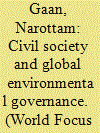

|
|
|
|
|
| Publication |
2013.
|
| Summary/Abstract |
The relation between civil society and environmental governance is not new. A number of developed states have introduced systems of green house gas emissions controls, but policy experience in this area is barely fifteen years old. Initiatives around adaptation are newer still. Thus societies are only beginning to learn what approaches are more or less promising. The power of ideas and the possibility of re-defining what is considered 'normal', 'possible' and 'acceptable' is often neglected in policy discussion. An example of power of ideas to shift policy frames is provided by the turn towards free markets and away from state provision that occurred in 1980s. Over the course of decades reforms aimed a reining back government and encouraging market growth dramatically altered expectation about boundaries of public- private economic activities-that is of civil society in broader sense.
|
|
|
|
|
|
|
|
|
|
|
|
|
|
|
|
| 2 |
ID:
099649


|
|
|
|
|
| Publication |
2010.
|
| Summary/Abstract |
With the first commitment period of the Kyoto Protocol expiring in 2012, time seems to be running out for a new successor agreement. The Protocol remains the most comprehensive attempt to negotiate binding limits on anthropogenic greenhouse gas (GHG) emissions. The long-term challenge, defined by the United Nations Framework Convention on Climate Change (UNFCCC), is to stabilise GHG concentration in the atmosphere at levels that would prevent interference with the climate system. There are, however, economic and social realities that drive anthropogenic GHG emissions. States face serious challenges of balancing economic growth on the one hand, and sustainability of natural resources and energy choices on the other. This dilemma has for long defined and continues to underline the climate change debate. This article chronicles the process of climate change negotiations and examines the political deadlocks through scientific uncertainties, lack of trust-building, inadequate leadership and political regrouping.
|
|
|
|
|
|
|
|
|
|
|
|
|
|
|
|
| 3 |
ID:
143020


|
|
|
|
|
| Publication |
Gurgaon, LexisNexis, 2015.
|
| Description |
xvi, 203p.hbk
|
| Standard Number |
9789351436829
|
|
|
|
|
|
|
|
|
|
|
|
Copies: C:1/I:0,R:0,Q:0
Circulation
| Accession# | Call# | Current Location | Status | Policy | Location |
| 058428 | 320.40954/MOD 058428 | Main | On Shelf | General | |
|
|
|
|
| 4 |
ID:
137776
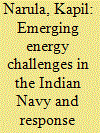

|
|
|
| 5 |
ID:
127523
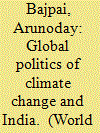

|
|
|
| 6 |
ID:
118150


|
|
|
| 7 |
ID:
105763
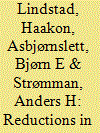

|
|
|
|
|
| Publication |
2011.
|
| Summary/Abstract |
CO2 emissions from maritime transport represent a significant part of total global greenhouse gas (GHG) emissions. According to the International Maritime Organization (Second IMO GHG study, 2009), maritime transport emitted 1046 million tons (all tons are metric) of CO2 in 2007, representing 3.3% of the world's total CO2 emissions. The International Maritime Organization (IMO) is currently debating both technical and market-based measures for reducing greenhouse gas emissions from shipping. This paper presents investigations on the effects of speed reductions on the direct emissions and costs of maritime transport, for which the selection of ship classes was made to facilitate an aggregated representation of the world fleet. The results show that there is a substantial potential for reducing CO2 emissions in shipping. Emissions can be reduced by 19% with a negative abatement cost (cost minimization) and by 28% at a zero abatement cost. Since these emission reductions are based purely on lower speeds, they can in part be performed now.
|
|
|
|
|
|
|
|
|
|
|
|
|
|
|
|
| 8 |
ID:
105160
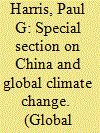

|
|
|
|
|
| Publication |
2011.
|
| Summary/Abstract |
Climate change presents much of the world, and possibly most of it in the long term, with chronic human insecurity. More than any other country, China has become a central actor in the practical and political aspects of this problem. On a practical level, it is the largest national source of greenhouse gases (GHGs) causing global warming, and the rapid increase in its GHG emissions means that its contribution to climate change will continue to grow for some time. Politically, China's role in climate change diplomacy is crucial to so-far failed efforts by states to reach consensus on robust efforts to reduce GHG pollution and to respond to the inevitable consequences of climate change. China's domestic policy responses to the problem convey important signals that will influence the behaviour of other national actors. Without China playing a major part in efforts to curb GHG pollution, notably through limitations on its future emissions, international efforts to mitigate global warming substantially will certainly fail.
|
|
|
|
|
|
|
|
|
|
|
|
|
|
|
|
| 9 |
ID:
090098
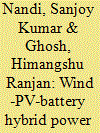

|
|
|
|
|
| Publication |
2009.
|
| Summary/Abstract |
The measured wind data of Local Government Engineering Department (LGED) for 2006 at 30 m height shows a good prospect for wind energy extraction at the site. For a few months and hours the speed is below the cut in speeds of the available turbines in the market. The predicted solar radiation data from directly related measured cloud cover and sunshine duration data of Bangladesh Meteorological Department (BMD) for 1992-2003 indicates that a reliable power system can be developed over the year if the solar energy technology is merged with the wind energy technologies for this site. This research work has studied on optimization of a wind-photovoltaic-battery hybrid system and its performance for a typical community load. The assessment shows that least cost of energy (COE) is about USD 0.363/kWh for a community using 169 kWh/day with 61 kW peak and having minimum amount of access or unused energy. Moreover, compared to the existing fossil fuel-based electricity supply, such an environment friendly system can mitigate about 25 t CO2/yr. The analysis also indicates that wind-PV-battery is economically viable as a replacement for conventional grid energy supply for a community at a minimum distance of about 17 km from grid.
|
|
|
|
|
|
|
|
|
|
|
|
|
|
|
|